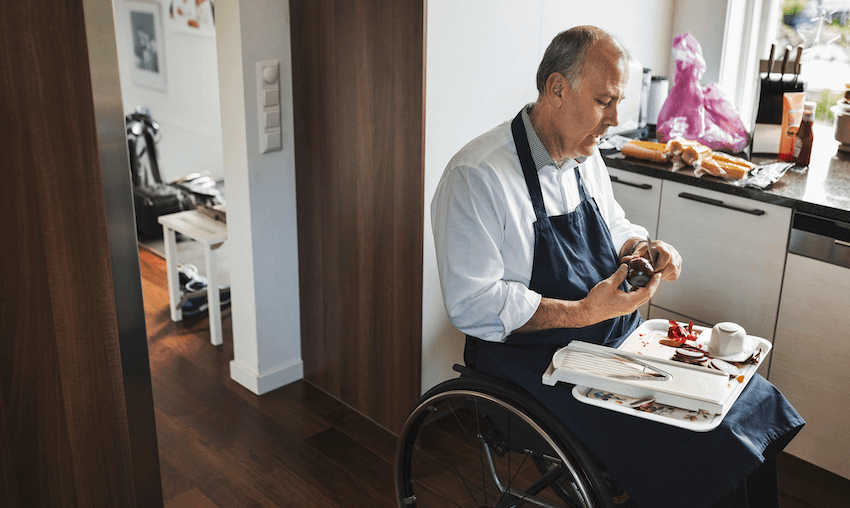A new report reveals the breadth of the loneliness epidemic among the disability community, writes Robyn Hunt – and provides a useful path towards more meaningful human connection.
Still Alone Together sounds like a contradiction. It is the title of a very readable report from the Helen Clark Foundation and the consultancy WSP that explores loneliness during last year’s lockdown. The findings are described in the report as “stark and alarming”, confronting for some readers. It reveals that disabled people are four times more likely than non-disabled people to report feeling lonely most or all of the time. Ten percent reported that they feel lonely most or all of the time.
But disabled people be like “What’s new! We’ve been telling you about all the concerns and problems behind these results for years.”
What is new is the quality of the data available. This survey is a follow-up to Alone Together, published in June 2020. Since then Statistics New Zealand has changed the way wellbeing data is collected and has provided some more revealing data relating to disability.
Of course it is important for disabled people to be included in the data, and the data is compelling. Others who are particularly lonely are unemployed people; those on low incomes; single parents with children, often women; young people aged 15 -24; Māori; Asians and new migrants. Of course there is considerable overlap and intersectionality among the groups, as the report notes.
For disabled people the situation is complex. Many feel isolated, disconnected and left out, with few social supports. Humans need connection; not being connected in ways that enable us to flourish is bad for our health and wellbeing, with all kinds of social and economic implications for us and our communities. Connection can be achieved in a number of ways; it’s not only about being around other people. A person can be lonely is a celebratory and happy crowd if they are not welcome or included. To always be the outsider is a lonely place.
Not feeling welcome is something many disabled people know well, whether it is trying to find an accessible home, an accessible bus or taxi, an inclusive sports or community group, visiting a museum or restaurant, finding some important information on a poorly designed web site, or getting help to find the right assistive technology that works for them, so they can chat with their friends online.
Simply being the only one like you in a particular situation can be a lonely experience. Spontaneity can be difficult when everything has to be planned carefully in advance. For some disabled people their basic human choices, such as whom to live with, are constrained in ways others’ are not. Not having an equal and meaningful place at the table where matters that directly concern us are considered is alienating and exclusionary.
Everyday ableism – embodied in negative attitudes to disability and the frequent power imbalances between disabled people and those who control the resources we need – contributes to alienation and loneliness.
Solitude does not always mean loneliness. But if it is not freely chosen, but instead imposed by circumstance beyond one’s control, it can be damaging. This happened to some disabled people who had difficulty accessing their usual supports during level four lockdown. For Deaf people, lack of access to Sign Language and others in the Deaf community would be lonely at any time.
It will take more than a visit from a caring neighbour or two to tackle these systemic issues, although that might be a good start for some people.
Still Alone Together takes the fairly unusual and welcome step of including the voices of disabled people and their representative groups and families. The uncompromising Q&A with Prudence Walker, disabled CEO of the Disabled Persons Assembly, a pan-disability organisation, directly confronts damaging assumptions about disability and clearly explains the modern understanding and meaning of disability. It should be required reading for all public policy makers.
Elsewhere Jonathan Mosen, the blind and hearing-impaired CEO of national disability employment agency Workbridge, makes the case for employment of disabled people. Disability leadership can sometimes be a lonely place when there are still too few in a range of employment roles.
The report also refers to Spaces of Belonging, a 2019 collaborative research project between disabled and non-disabled organisations that explored “disability spaces”. A key finding was that such spaces should be designed to support “access and participation,” and not be old-style disability ghettos, the result of lack of choice, segregation and marginalisation. I like the idea that these spaces can be “sites of resistance to ableism”, fostering healthy disability communities where people can identify common experiences and understandings.
The Still Alone Together report makes six recommendations:
- Everyone has enough money
- Close the digital divide
- Help communities do their magic
- Create friendly streets and neighbourhoods
- Prioritise those already lonely
- Invest in frontline mental health
There’s a lot to unpick here. Addressing these recommendations would make a significant difference to people’s lives. The report outlines where there has already been some progress on several, and little or none on others. An update report on progress at a later date would be welcome.
In the spirit of “nothing about us without us”, the disability catch cry, it is good to see this report produced as an accessible pdf and in plain language formats at the same time as the usual pdf. It should be read widely, both by those within the disability community and outside it.
‘Still Alone Together How Loneliness changed in Aotearoa New Zealand in 2020 and what it means for public policy’ is published by the Helen Clark Foundation and the engineering research firm WSP, and is part of the Post-Pandemic Futures series.
